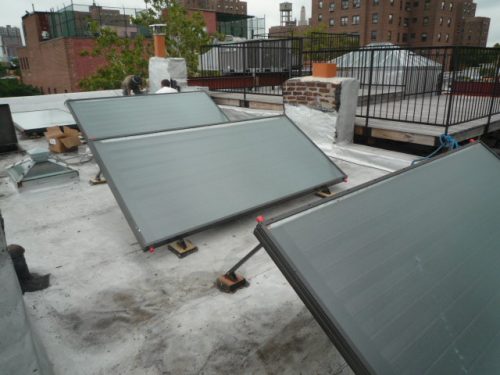There is an increasing opinion amoungst New York solar installers that solar thermal pays for itself quicker than solar PV.
Looking at the numbers I thought so too and would recommend solar thermal as a better investment if the client had to choose between solar PV and thermal. Of course it is great when the client can afford both a solar thermal and PV installation since both have their benefits.
However there has been an interesting discussion on one of my email lists between solar experts. They are finding that maybe that assumption is wrong.
This is a big deal since solar panel installations, whether Photovoltaic for electricity or Thermal for hot water heating, are usually a large part of a homeowners renovation budget. If in fact solar PV does have a better payback that solar thermal installations in New York then this may change the way we do business.
Here is one comment:
We have found precisely the same with our net zero houses in Edmonton: grid-connected solar PV can be less expensive than solar thermal. This happens for a number of very interesting reasons:
a) solar PV is grid-connected and so does not have to pay for its own energy storage. Solar thermal is off-grid and so has to incorporate and pay for its own energy storage. Both have to pay for grid back-up of course.
b) High-fraction solar thermal wastes a lot of its energy in the summer because its energy storage is so limited, whereas grid-connected solar PV keeps on generating into the grid.
c) Grid-connected solar PV is very simple compared to solar thermal, especially high-fraction solar thermal, and especially active solar thermal space heating.
If solar PV was off-grid then much of its advantage over solar thermal would disappear.
The perception is that solar PV modules are much more expensive ($700/m2) and much less efficient (17%) than active solar thermal collectors ($300/m2 and 70% efficient)… well this changes in reality. One needs to consider the costs of systems and not solar devices, as well as the efficiencies of systems and not solar devices. High-fraction solar thermal has very low efficiencies in the summer because the solar energy is mostly wasted.
The keys in all this are “high-fraction” solar thermal — if it is a low-fraction solar thermal situation then there is not nearly as much energy spillage in the summer, the solar thermal system operates at its high-efficiency range much more often, and its balance-of-systems are much less complex and expensive. In addition, high-fraction solar thermal systems have much much higher BOS costs with all the storage, piping, valves, heat exchangers and on and on and on. Grid-dependent solar PV has a bit of wiring, 1 disconnect and an inverter for its BOS costs and complexities.
In 2004 I thought that “when solar PV generates energy more cheaply than solar thermal, then solar thermal would be dead in the water”. I had expected this to happen by 2020 or so… little did I know that I would be seeing the first examples of this with the Riverdale NetZero house in 2007! www.riverdalenetzero.ca The active solar thermal space-DW heating system cost $36000 and provides 4200 kWh of energy per year. The 5.6 kW solar PV system cost $45000 3 years ago (and $38000 now) and generates 6300 kWh per year. Do the math: solar thermal cost $8.57 per annual-kWh plus maintenance costs and a 20-year lifetime; solar PV cost $7.14 per annual-kWh (in 2007, $6.20 now) with basically no maintenance and 50-year lifetime for modules and 15-year (plus) lifetime for inverter. As a result our Mill Creek NetZero house www.greenedmonton.ca has a much simpler solar thermal system, and our Belgravia NetZero house has no solar thermal system — only ultra efficiency, ultra passive solar, solar PV and electric baseboards — very simple, much less expensive (no cooling loads here).
See www.hme.ca/presentations for a number of presentations that illustrate this. I am not against solar thermal at all… just show me the numbers, and let’s see whether solar PV can out-compete or not. The Drake Landing Solar Community www.dlsc.ca is a great project, great technology, and another great example of PV vs thermal. The homeowners’ heating bills would be less without the solar thermal system than they are now!!! and solar PV could be installed today for 1/2 the public funding that was initially required for solar thermal, plus the homeowners would not have any solar utility management fees!
————————

